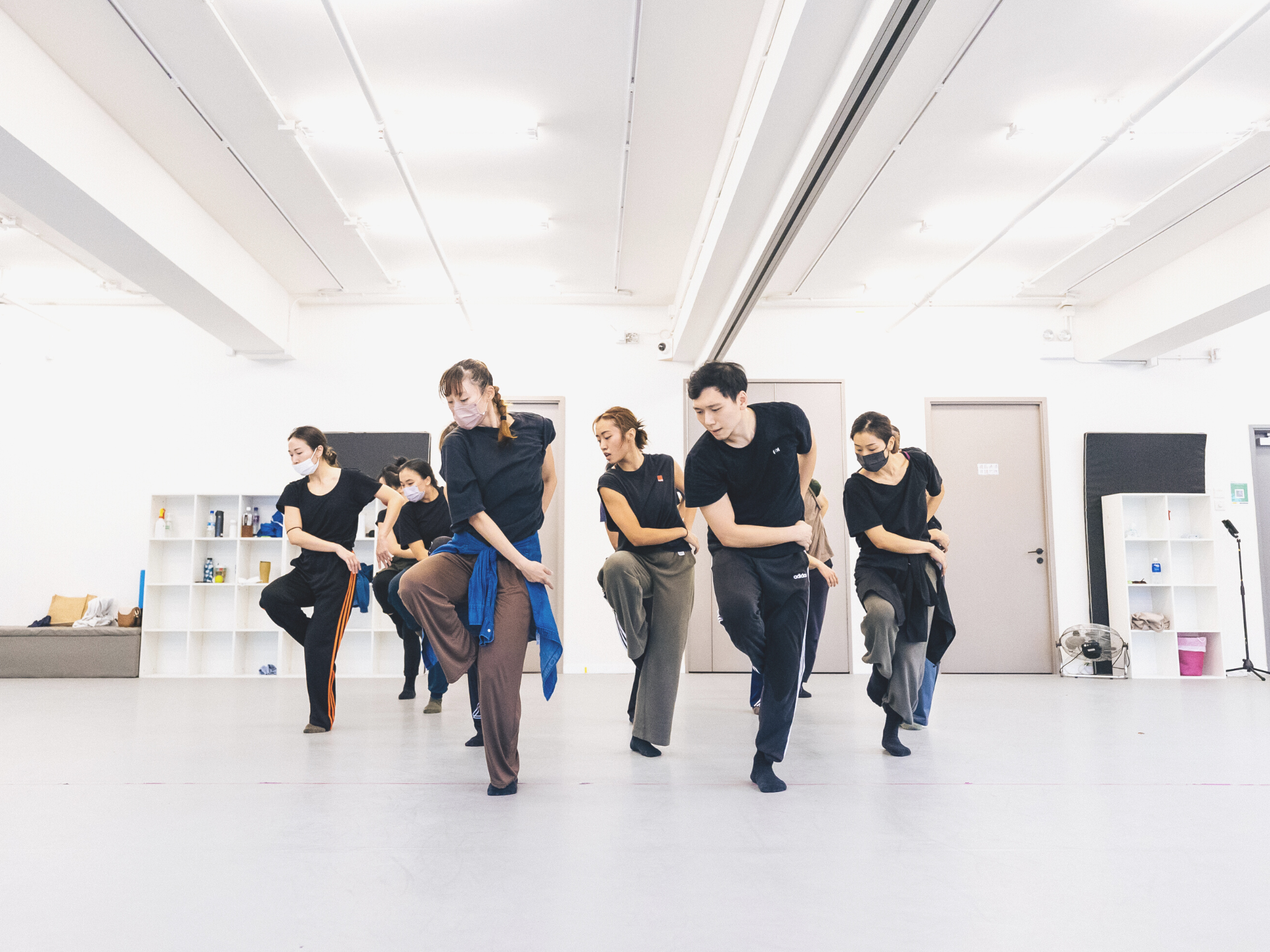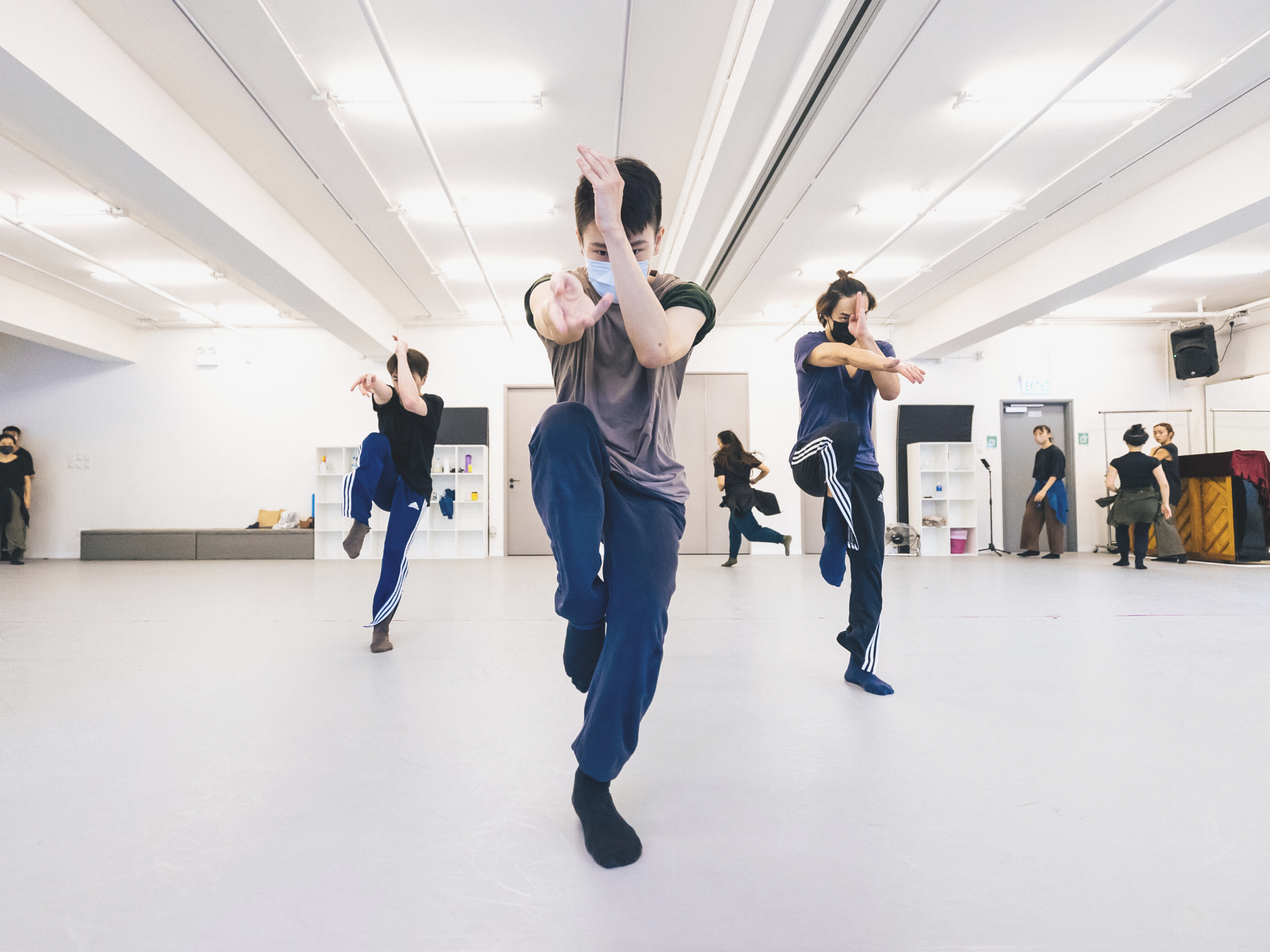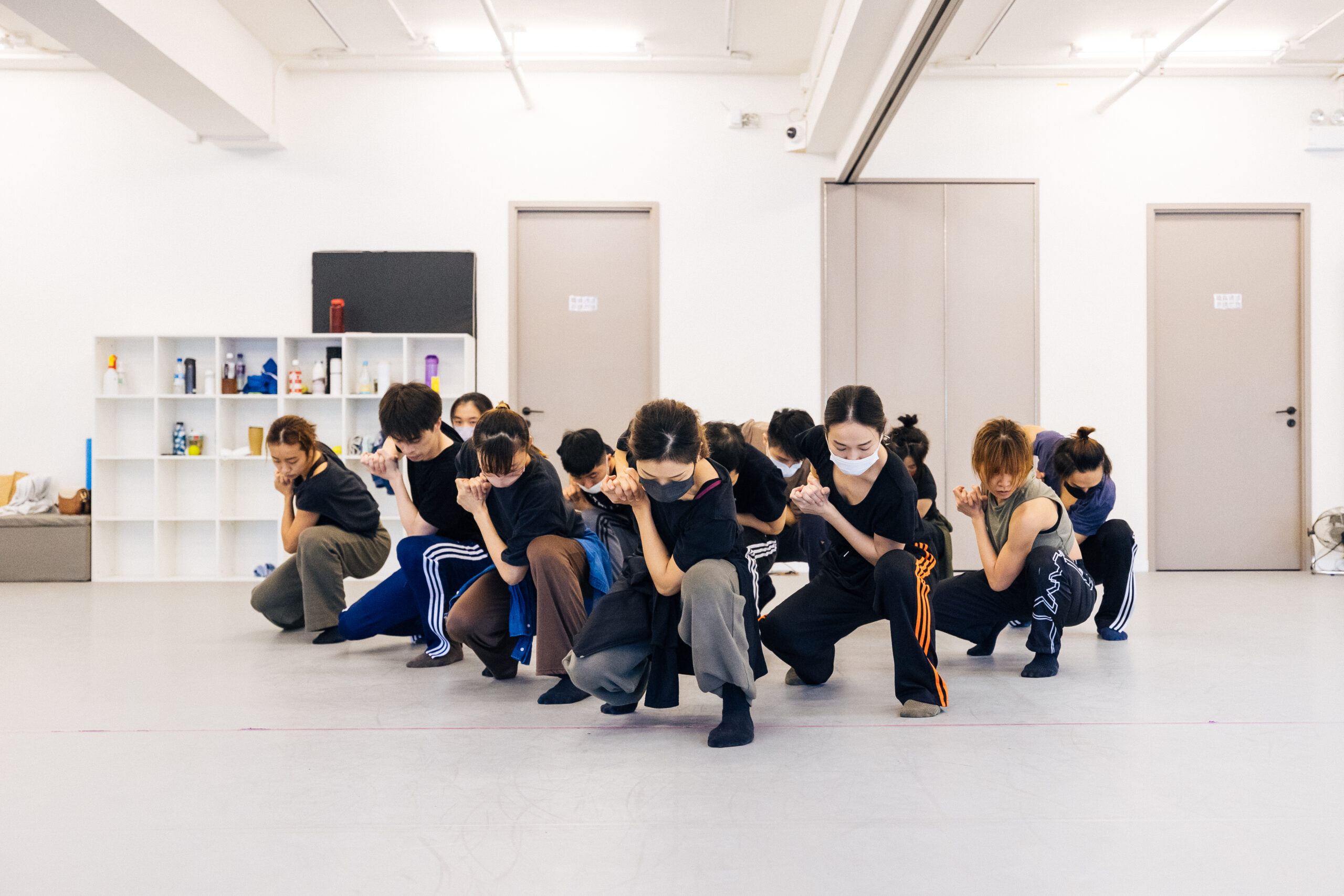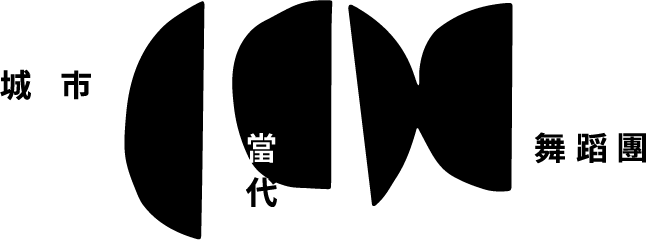Kim Jaeduk’s Brown, Anti-Essentialism, and Contemporary Intercultural Dance
Written by Yoon Soo Ryon (Performance Researcher)

In Brown, dancers diverge into groups of two or three from one large mass as if to branch out from a tree. They proceed to movements in unison that feature leaning torsos and small kicks with their hands on their backs. Their knees are ever so slightly bent enough to allow for continuously elastic and bouncy moves, letting their bodies bob up and down. Background music of Kim Jaeduk’s own composition plays a medley of string instruments and percussions resembling the sounds of knocking on wood, which slowly builds up to its climactic moment. Yet the repetition of beats and melodies somehow constantly resists overly dramatic development of music.
To Koreans like myself, some of these may be easily recognisable as rooted in, or at least inspired by, traditional music and dance. Small kicks, lifted feet in a balancing act, gestures of tossing sleeves behind shoulders, and springy movements remind me of the footsteps or baldidim in salpuri (shamanic dance) and repeated bounce or gulsin in chaesangsogochum (hand-held small drum dance). The sounds resemble that of ajaeng (7-string bass instrument) and buk (drum).
Of course, even if an audience member had no idea what the cultural heritage behind these movements was, it does not impact one’s viewing experiences. In fact, it is the choreographer’s very intention that the cultural signifiers in Brown remain as obscure and abstract as possible, even as they are still embodied by the CCDC dancers. Any audience efforts to identify Kim’s choreography with a specific cultural label will further fail because of the choreographer’s use of earth tone masks and gloves, which hide dancers’ flesh, skin, and facial expressions. Kim Jaeduk purposefully departs from territorialising Brown into any specific cultural or national category and resists the idea of reducing his new work to a contemporary-meets-tradition cliché or a Hong Kong version of Korean dance.
In this vein, can Brown demonstrate ways in which we can still consider a cultural identity of dance while avoiding cultural essentialism? Does the innate sense of Koreanness embodied through the traces of folk and traditional elements transform into something else, as the work is performed by Hong Kong-based dancers? Or, in another sense, does the experience of performing Kim’s piece change the CCDC dancers’ own sense of their cultural identities as well as biases? How does Brown attempt to work across different cultures while simultaneously critiquing our impulse as viewers and artists to contain something into a cultural symbol?
This essay is less interested in defining whether the Kim Jaeduk-CCDC collaboration Brown is intercultural or not. I am much more interested in reading the choreographer’s new work against the grain in terms of how it complicates existing contemporary dance idioms and traditional cultural elements, the latter being the iconic part of Kim’s oeuvre in the international context. This is to say that Kim’s Brown pries open a new space for thinking about what is contemporary in contemporary dance, how we use colour and tactility as a framework for choreography, and how cultural differences co-exist within the work without resorting to cultural essentialism and stereotypes.[1]

Understanding Intercultural Performance (and Its Discontent)
While this essay cannot rehearse the history and theories of intercultural performance, surveying its concept and overall context even briefly may be useful, particularly for the viewers who are introduced to interculturalism for the first time.
Interculturalism, commonly translated into 跨文化主義 in Canto-Chinese, refers to a range of perspectives, approaches, techniques, practices, and interpretations that privilege cross-cultural dialogue and hybridity as key themes and methods when it comes to performance making. Interculturalism in dance and theatre experienced resurgence between the 1980s and the 1990s in response to the emergence of critical, avant-garde, postcolonial, and multicultural thinking, especially as an attempt to decentre European hegemony in the field. From the intercultural perspectives, two or more cultures do not merely come together to showcase an assemblage of cultures; rather, they are meant to create a new and alternative method to dance and theatre making beyond existing forms. What comes to mind are the instances where European canons like Shakespeare’s The Tempest are rewritten as a postcolonial “talkback” to incorporate Asian traditions such as Japanese noh (e.g. Yukio Ninagawa’s 1988 production) rather than reconstructing the Elizabethan performance. The Chinese word “跨” seems apt in this sense, as it implies acts of crossing or exceeding (cultural) borders.
Interculturalism in performing arts, however, has been also met with criticism over the years, especially from non-Western critics, artists, and scholars who observe that intercultural performing arts often appropriate and heavily rely on using Asian or non-Western cultures as raw materials reworked by Euro-American artists (or by non-Western artists trained in the European tradition). In many intercultural performances, non-Western local and indigenous components are featured as folk, traditional, or cultural, while getting repurposed through the languages of Euro-North American “contemporary” theatre and dance aesthetics, which positions the non-West as the premodern Other. Asian practitioners themselves are not immune to the impact of European hegemony, as Asian artists also mobilise traditions to reinforce their own orientalist fantasies.[2] In this sense, one may ask (and to recall the Chinese word “跨”): who can afford to cross the cultural borders when the cultural relationships are always already fraught with uneven power, inequality, and hierarchy? Indeed, many artists and critics have raised similar questions. Rustom Bharucha’s critique of Peter Brook’s Mahabharata [3] or Ananya Chatterjea’s observation of intercultural contemporary dance share concerns about how intercultural projects often continue to reinforce the unfair relationships between Euro-American artists and the rest of the world. Chatterjea, for instance, notes,
[T]he severing of movement content from structure and context that plagued past multicultural endeavors continues through the staging of global and intercultural projects where all too often forms and performers from Asia and Africa are mobilized only to ensure the ascendency of Euro-American aesthetics.[4]
Given this, instead of thinking about what a (successful) intercultural performance looks like, scholars like SanSan Kwan and I-Wen Chang call our attention to artists’ constant efforts to approximate an ethical dimension of cross-cultural performance or formulate a new geopolitical site of knowledge outside the Euro-American force field of cultural hegemony.[5] Situating our viewing experiences in this context, what do we now see as strategies in Kim Jaeduk’s Brown that displace Eurocentric contemporary aesthetics toward creating a new movement language?

Kim Jaeduk’s Contemporaneity and Anti-Essentialism
For Kim and in his recent works, what truly becomes contemporary (현대적 現代的) as well as contemporaneity (동시대성 同時代性) is not a mere inversion of the past/traditions: using obvious components of experimentalism such as electronic dance music, metallic avant-garde costumes, and complex lighting works is only part of the modernistic transitions in the long process of still finding one’s own artistic language in the present moment. In his recent works including Brown, Kim seeks to return to studying the most basic, fundamental elements of our everyday objects, gestures that we embody from a very early age (such as the traces of traditional movements I mentioned earlier), and colours of our surroundings, of soil, trees, cloud, air. The music throughout the piece oscillates between the acoustic and the electronic, sometimes subdued and at other times explosive. But permeating through all of these changes is Kim’s emphasis on the sensorial experiences of feeling the touch of wood through the cello and ajaeng-like string sounds or the visual impact of brown masks and gloves, which are meant to transform the dancing bodies into unnameable posthuman figures. Again, these components may conjure up certain images for viewers, but depending on their own contexts, they will mean different things. The colour brown may appear to resemble that of natural clay used in Korea, but for some, it could be the colour of the leatherwood native to Australia.
All of these raw, elementary components compel the audience members to pay attention to the new dance language being produced on stage, instead of looking for typical cultural identifiers, prompting both the CCDC dancers and local viewers to confront their own cultural biases: Brown’s contemporaneity thus becomes cultural without being culturally essentialist. Because of this, Kim purposefully avoids executing perfectly upright torso movements, or associating the colour brown with culturally specific origins, or labelling the sounds with either “Asian” or “Western” qualities. During the rehearsal process, some of the young CCDC dancers often went through multiple trials to understand the essence of Kim’s philosophy, which required them to eventually undo and rethink their bodies trained in Euro-American contemporary dance or Western classical ballet. This did not, however, mean that the dancers had to learn Korean cultures or to return to their Chinese cultural roots. The undoing of their training prompted them to interrogate their own cultural identities while moving in a new, anti-essentialist choreography that still respected the tensions and intercultural dialogue present in the relationship between the choreographer and the dancers, between the work and the local viewers, between the choreographer’s own past, present, and future aesthetics.
Dancing against the Grain
In a way, Kim Jaeduk’s new work requires all of us to “dance” against the grain. The word “grain” is also used in “wood grain,” which refers to the “longitudinal arrangement of [wood] fibre or particles.”[6] By troubling what feels normal and familiar to us as the linear “arrangement” of cultures on stage, Kim Jaeduk, in collaboration with CCDC dancers, wants us to critically rethink the intercultural in progressive, visceral, and most importantly, contemporary ways as much as possible.

Author Bio
Yoon Soo Ryon, PhD, is a performance researcher and dance historian. She has written about performance theories and racial-gender politics in the South Korean and East Asian context. She was a postdoctoral associate at Yale University and taught at Lingnan University as an assistant professor in Cultural Studies. She recently co-edited a special issue of the Inter-Asia Cultural Studies journal on dance, inter-Asia, and cultural politics.
—
[1] I draw many of the points and questions I raise here from my interview with Kim Jaeduk, 4 October 2022, Gwacheon, South Korea.
[2] See I-Wen Chang’s piece (2021) on the politics of representation in intercultural and transnational Asian performance production A Thousand Stages, Yet I Have Never Quite Lived (2021): 張懿文, “【Reread:再批評】從兩廳院Taiwan Week性別失衡危機談起——論國家級表演場館之自我定位、國際想像與本地藝術生態(上)”. 表演藝術評論台. 12 July.
[3] Rustom Bharucha. 1988. “Peter Brook’s ‘Mahabharata’: A View from India.” Economic and Political Weekly 23 (32): 1642-1647.
[4] Ananya Chatterjea. 2013. “On the Value of Mistranslations and Contaminations: The Category of ‘Contemporary Choreography’ in Asian Dance.” Dance Research Journal 45 (1): 7-21, 14.
[5] SanSan Kwan. 2014. “Even as We Keep Trying: An Ethics of Interculturalism in Jérôme Bel’s Pichet Klunchun and Myself.” Theatre Survey 55 (2): 185-201; I-Wen Chang. 2022. “Dancing me from South to South: on Wu-Kang Chen and Pichet Klunchun’s intercultural performance.” Inter-Asia Cultural Studies 23 (4): 611-626.
[6] “Grain.” Entry 15. The Oxford English Dictionary.


